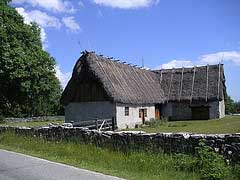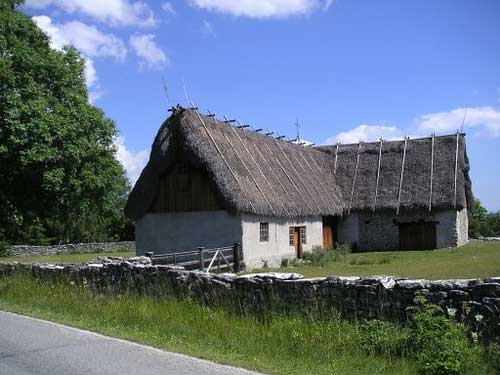This building is a wonderful old house at Stora GÃ¥semora, on FÃ¥rö, our favorite island outside the island Gotland on Swedens east coast. I don’t know exactly when that house is dated, because there are several buildings from between 18th – 20th centuries.
The thatched sedge roof is a very particular custom at these two islands, perhaps the most exotic part of them, mainly in the northern part of Gotland with Fårö. The tradition is still continued, mainly to keep the knowledge going, the technique is rather complicated.
Every year there are roofs that is replaced or repaired, often with some help from government funds. The public can study or even participate in this procedure, it’s announced in the media as “Täckatingar”.
The straws (Ag) are grown on the island and the tradition to use it as roof material is ancient at Gotland, how old is difficult to know. The ag roofs is laid mainly on barns and lamb houses (lambgift in Gotland), but has under pre-historical time even been on the residential buildings.
During his trip to Gotland in the year 1741, Carl von Linné writes in his Diary:
“We had not lost the sight of Lummelunds Church before we saw on the left side a big marsh, which was called The church bog, in which it grew a tall grass all over, as seed in the field, it was up to 2 m tall and was called ag… The people cover their roofs on the barns with it, they harvest it with a scythe between midsummer and Ols mass, put it tied and undried together at different directions and because of that it becomes more dense and prolonged than normal straw.”
The work is done under something called “täckating” (like cover session) which means that the täckarlaget (cover team) works without any other pay than food and drink during the day.
The roof shall be steep and be constituted of so called “raftar” which is resting between the roof foot and the ridge. The Ag layers are thick, 70-80 cm, and is packed with help of a so called “täckastake” (cover stake).
Then the roof is attached with something called vidjor, which probably is the most difficult task. After several ending moments the roof is ready and a party with food, drinks and music can start.
If the work is proper done and maintained, the roof can hold for about sexty years!
I love to see all those Ag roofs around the island, it gives a certain old atmosphere that I find so tremendously charming.
Ag wasn’t only used as roof cover material but even as stuffing in the bed, because they wanted to save the normal straw to the animals during the long winter.
Ag is a kind of half grass, almost like reed…
I’m so glad that I don’t have it in our mattress!!!
UPDATE: I read somewhere that it exist about 146 buildings with ag roofs in Gotland and 78 of them is in Fårö. That is a lot on such a small island!



What an interesting story. If the animals get hungry for a snack at night do they climb a ladder and eat the roof..
Lifecruiser: You’re just so crazy H&B2! And that’s why we love you so
There is mostly sheep’s on FÃ¥rö, but they call them lambs, even if they are sheep’s….
So if you can’t sleep when on FÃ¥rö, we don’t count sheep, we count lambs.
Now, what have we said about night snacks? Always go for a snack!
I bet they are sheep’ish enough to try….
Thanks for sharing. They have thatched roofs in Ireland too but not many left. Toodles~
Lifecruiser: Yes, I do think they are spread hera and there in some Europe contries, but there is fewer and fewer left since they need knowledge to maintain and to get the right stuff. That’s why the government contribute to this here too. To preserve old tradtitions.
Nice to hear that your matress is filled with straw, isn’t that a little hard ? I also love these houses, there are very few along the belgian coast. Anyway on my travel list I have put “the northern countries” and my dream is to make a cruise (not a lifecruise)around there before I go to heaven (where ever that is)
 (H & B told us to mention important people and pretend to know them in our blogs !)
(H & B told us to mention important people and pretend to know them in our blogs !)
As a well educated girl I knew what a Troll is ! I have listened to the children tales ! And … don’t forget that your queen is one of my friends, I went to school with her
Lifecruiser: I think you read that like you wished that it had said Ahhhh, a cruise….. Yes, sounds wonderful. In the summertime though. Why don’t we have more time here in life? This world is too big, too much to experience!
Ahhhh, a cruise….. Yes, sounds wonderful. In the summertime though. Why don’t we have more time here in life? This world is too big, too much to experience!
About that troll busniess… There is a word in Swedish: trollpacka, that’s difficult to translate, something like a combination of troll and witch. Thats me
So you have been gossiping with the queen hah? I hope she didn’t tell you about that time when I met the King…. Oooops, perhaps I shouldn’t reveal that fact…. *lol*
Aha, now I know why Paola almost divorced Albert ! Because of you !! I will immediately call the press !
We have all got the order to Click & Comment, which I herewith do ! And that was good, otherwise I would never had seen your comment on my comment (sounds good) Once I were on a blog I never go back there for the same post so it’s better you comment my comments in your comments in my blog’s comments. Do you think I commented enough ???
I hope I will get a Click & Comment award for that !
And I even didn’t write : Nice pictures ! (and on the blog is only a text) !
Lifecruiser: Schhh! don’t tell anyone!!! What can I offer you….? *lol*
Maybe we should rename that click and comment to madclick and madcomment instead…. ha ha…. I’ll start my madmoments any moment now….*lol*
I think that is so cool that they continue to replace these roofs just to keep the knowledge of HOW TO going! I wonder how many arts like that have been lost to the American people because land was considered too precious to grow something like the straw for a roof when we could so much more easily put shingles up! And they are sO pretty have so much character! LOVE it!
Lifecruiser: Yes, we are so happy that they do too! I love old tradtitions of almost any sort!
interesting
Lifecruiser: I’m glad you find it interesting Lorna